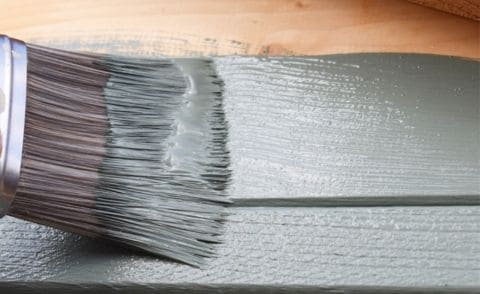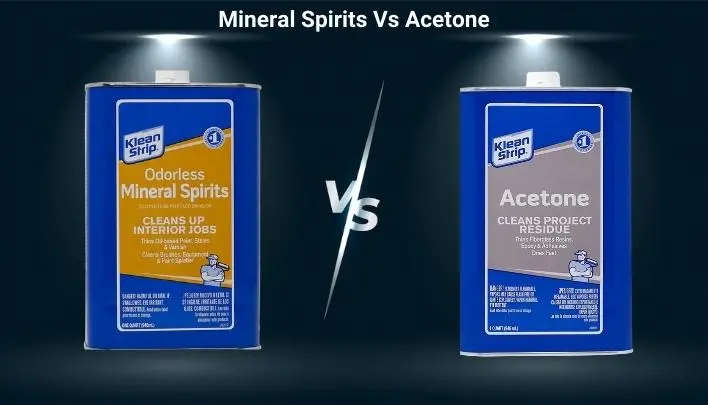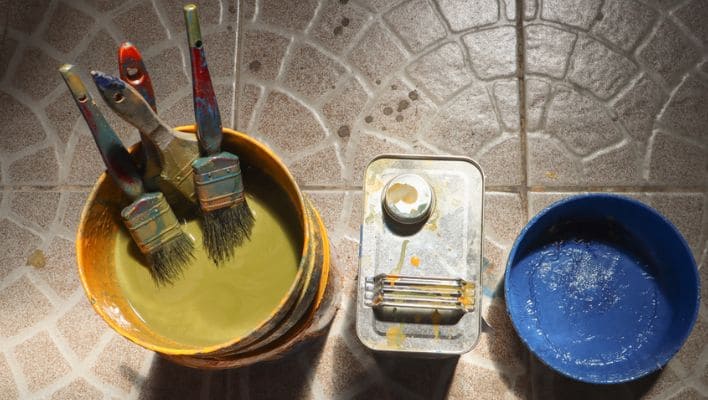When it’s time to give your home a new look, it’s important to make smart choices. You might be dealing with the question of whether to apply latex paint over oil-based or oil-based paint over latex. In this situation, it’s worth noting that applying oil-based paint over latex isn’t the most recommended choice by professionals, although it’s possible.
The primary concern is that latex paint is inherently flexible, making it less compatible with the adherence of oil-based paints. This can lead to paint not sticking as securely as it should, potentially causing issues down the road.
In the following paragraphs, I will explain to you about the compatibility of these two paint types and provide guidance on the best approach for your painting project.

Table of Contents
- Can You Put Oil Based Paint Over Latex? Quick Summary
- How can you tell if existing paint is oil based Or Latex Based?
- What happens if you put oil-based paint over latex?
- How to Paint Oil-Based Paint Over Latex?
- 1. Surface Preparation:
- 2. Sanding
- 3. Apply the Primer
- 4. Oil-Based Paint Application
- 5. Allow for Drying:
- 6. Multiple Coats:
- 7. Cleanup:
- how to paint latex paint over oil based paint?
- Surface preparation
- Drying time
- Apply the Bonding Primer
- Drying time
- Paint Latex Over Oil based Paint
- Sherwin Williams latex over oil paint
- Painting over latex paint with acrylic
- Can you use Kilz oil-based primer over latex paint?
- Conclusion:
- Martina Hitchcock
Can You Put Oil Based Paint Over Latex? Quick Summary
For a successful paint job, it’s important to use compatible paints. As I said above, you can safely apply latex paint over oil-based paint, but the opposite isn’t recommended.
However, if you need to use oil-based paint over latex, there’s a solution. By sanding the surface and applying a sealing coat like a primer between the layers, you can make it work.
If you don’t execute this process correctly, it can extend the time required to complete your painting project. Insufficient preparation can also impact the new paint’s ability to adhere to the old paint, resulting in issues such as cracking and peeling.
How can you tell if existing paint is oil based Or Latex Based?
| Test Method | Required Materials | Procedure | Results |
| Acetone Test | Nail polish remover or acetone | 1. Apply a small quantity of nail polish remover (which contains acetone) on a cloth or paper towel. | If the paint is visible on the cloth, it indicates latex paint. If no change is noticed, it suggests oil-based paint. |
| Alcohol Test | Rubbing alcohol, cleaning solution | 1. Clean the painted surface using a cleaning solution with warm water. 2. Allow the surface to dry. 3. Dampen a cotton swab with rubbing alcohol and softly apply it to the test area. | If paint transfers to the cotton swab, it signifies latex paint. If no paint comes off, it signifies oil-based paint. |
What happens if you put oil-based paint over latex?
Applying oil-based paint over latex paint can be a bit tricky. I once decided to freshen up the look of a room and mistakenly used oil-based paint over a latex-painted surface without proper preparation. Over time, I noticed that the newly applied paint started to peel and bubble, making the entire paint job look unsightly. It was a frustrating experience. You can check out the picture below;

To avoid this issue, I learned the importance of surface preparation. It’s crucial to clean and sand the existing latex paint and, if possible, use a suitable primer. This preparation helps create a better bond between the two different types of paint, preventing the peeling, cracking and flaking issues I encountered.
How to Paint Oil-Based Paint Over Latex?

1. Surface Preparation:
Start by thoroughly cleaning and degreasing the latex-painted surface. I usually use a combination of water and a gentle detergent as an effective cleaning solution.Once you’ve finished cleaning, make sure the surface is completely dry.
2. Sanding
To enhance adhesion, gently sand the latex-painted surface using fine-grit sandpaper (180 to 220-grit). This creates a textured surface for the primer to grip onto. Also, you can try high quality sanders to remove paint easily.
3. Apply the Primer
Use a high-quality bonding primer compatible with both oil and latex paints. Or using a bonding primer is an essential step when planning to apply oil-based paint over latex. Bonding primers are specifically formulated to adhere well to challenging surfaces, which significantly reduces the risk of adhesion issues. Opting for an oil-based bonding primer ensures a seamless transition when you apply the oil-based paint on top.
However, if you prefer, you can also consider using a water-based or acrylic primer as long as it is compatible with an oil-based paint topcoat.
4. Oil-Based Paint Application

Once the primer is fully dry, you can apply the oil-based paint. Use a good-quality paintbrush or paint sprayer for larger areas. Apply the oil-based paint in thin, even coats. Avoid heavy application to prevent drips and an uneven finish.
5. Allow for Drying:
Ensure each coat of oil-based paint dries completely before applying the next one. The drying times can vary depending on humidity and temperature, so follow the manufacturer’s recommendations.
6. Multiple Coats:
You may need to apply multiple coats of oil-based paint to achieve the desired coverage and finish.
7. Cleanup:
When dealing with oil-based paint, clean your brushes and tools using paint thinner or mineral spirits. Make sure to get rid of any waste materials following the rules in your area.
how to paint latex paint over oil based paint?
Here is a step-by-step guide to help you better understand the process.
Surface preparation
Begin by gently sanding the surface. This step gives the texture of a rough, which is important for the material to adhere properly. After sanding the surface, take a sponge and mix it with TSP. This can help remove dirt, grease or contaminants. Cleaning is an important first step.
Drying time
Let the surface air dry thoroughly, ensuring there’s absolutely no moisture left. Proper adhesion of paint depends on a dry surface.
Apply the Bonding Primer
Now, it’s time to use the bonding primer. You have the option to select either an oil-based or latex-based primer. Choose an oil-based paint like Kilz if the current paint is very shiny. A latex primer will work if the paint is not very glossy. In this step, you’ll be making sure that the new latex paint adheres well to the old painted surface.
Drying time
Patience is the key! Let the primer dry completely. The primer label will tell you how long to wait.
Paint Latex Over Oil based Paint
After the bonding primer has dried completely, you can start applying. To achieve the desired color and finish, apply two coats of high-quality latex.
Sherwin Williams latex over oil paint
Sherwin Williams latex paint can be applied over surfaces previously painted with oil-based paint, but proper preparation is essential. You should thoroughly clean and sand the oil-based paint, then use a latex bonding primer before applying the latex paint. This helps ensure good adhesion and a durable finish.
Painting over latex paint with acrylic
It is generally acceptable to paint over latex paint with acrylic paint. Acrylic paint is water-based and typically adheres well to latex surfaces. Ensure the latex paint is clean and in good condition, and you can apply acrylic paint over it for a fresh finish.
Can you use Kilz oil-based primer over latex paint?
Kilz oil-based primer is not recommended for use over latex paint. Oil-based primers and latex paint may not adhere well, potentially leading to issues like peeling. For better results, consider using a latex-based primer over latex paint.
Conclusion:
In conclusion, when considering whether to apply oil-based paint over latex, it’s essential to weigh the pros and cons. While it’s possible, there are potential challenges in terms of adhesion and long-term durability. It’s important to ensure proper surface preparation, such as thorough cleaning and sanding, and using a high-quality bonding primer. Additionally, for the best results, choosing a water-based or latex paint for subsequent coats might be a more reliable option.
Ultimately, the decision to use oil-based paint over latex should be made with care, keeping in mind the specific project’s requirements and the importance of proper preparation to achieve a successful and long-lasting paint job.

Martina Hitchcock
Martina Hitchcock is a versatile author with expertise in different fields. As a paint sprayer expert, she has in-depth knowledge of paint spraying techniques, tools, and equipment. Martina is also an experienced home remodeler who has worked on various projects, including kitchen and bathroom renovations, flooring installations, and room additions. Her knowledge of home improvement and remodeling is extensive, and she enjoys sharing her insights and tips with readers. You can follow her on Facebook.


